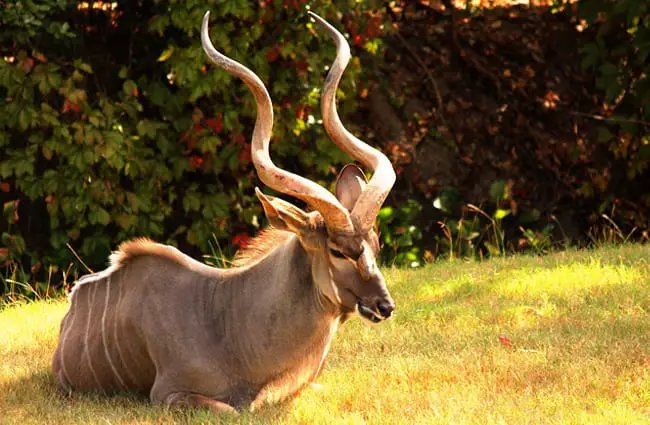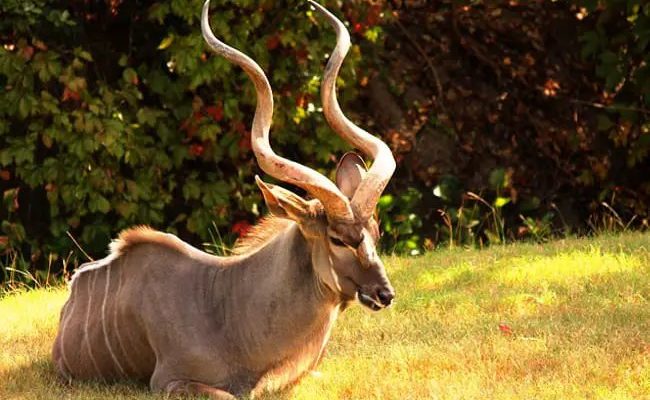
Kudus are divided into two species: the greater kudu and the lesser kudu. Each species showcases a variety of fascinating traits that reflect their exceptional lives in the wild. From their impressive size to their social behaviors, exploring the world of the kudu is like peeling back layers of a story that reveals just how captivating these animals really are. Let’s dive into the top ten facts about the kudu that you might find surprising.
1. Majestic Horns: Nature’s Curvature
You can’t talk about kudus without mentioning their impressive horns. Both male greater kudus and lesser kudus sport these spectacular spirals that can twist up to 1.5 meters in length! It’s like they wear nature’s trophy on their heads. Here’s the thing: females don’t have horns, so the males really stand out in social groups.
These horns aren’t just for show. In fact, they play a significant role in mating rituals. Males will often engage in displays of strength by clashing their horns together. This is Mother Nature’s way of showing who’s the boss! It’s pretty fascinating how something that looks so stunning also serves a practical purpose, right?
2. Striped Coat: A Perfect Camouflage
Kudus have a stunning coat that features vertical stripes running down their bodies. You might think they were painted by an artist! These stripes aren’t just a fashion statement; they serve a vital purpose in the wild. The pattern helps them blend into the thick brush of their environment, making them less detectable to predators. It’s like they have their own natural disguise.
Imagine walking through a dense forest. The sunlight filters through the leaves, casting shadows and patterns on the ground. With their stripes, kudus can effectively disappear into this dappled light. Predators like lions and leopards, who might be searching for a meal, often find it challenging to spot them when they’re standing still.
3. Size Matters: The Greater vs. Lesser Kudu
When it comes to size, kudus come in two distinct flavors: the greater kudu and the lesser kudu. The greater kudu is the larger of the two, standing about 1.2 meters tall at the shoulder and weighing up to 300 kilograms. To put that in perspective, that’s about the size of a small horse! On the other hand, the lesser kudu is more petite, weighing around 100 kilograms.
This size difference allows each species to occupy different ecological niches. Greater kudus are often found in open woodlands and savannas, while lesser kudus prefer denser thickets. If you happen to spot one in the wild, chances are you might only see its eyes peeking from behind the foliage!
4. Social Structures: Living in Herds
Kudus are quite social animals. Typically, they live in groups called herds, which usually consist of females and their young. Males are more solitary or form small bachelor groups when they’re not mating. Being social helps them maintain a level of safety in the wild.
You might be wondering how these herds function. Female kudus tend to be the caretakers of the group, and they communicate with each other through body language and vocalizations. When they sense danger, they send out alarm calls, alerting the rest of the herd. This communal awareness can be a game changer in avoiding predators lurking nearby.
5. Diet: Grazers of the Savanna
Kudus are herbivores, and their diet mainly consists of leaves, branches, and fruits. They have a unique way of feeding that allows them to thrive in their habitat. With their long necks and nimble tongues, they can reach leaves high up in trees where other grazers can’t. It’s like having a built-in salad bar in the treetops!
Because their diet allows them to browse selectively, kudus play a crucial role in their ecosystem. By feeding on certain plants, they help maintain the balance of the flora and fauna within their environment. The next time you enjoy a salad, think of kudus adding a little greenery to their life!
6. Water Needs: Adapting to Dry Conditions
While kudus enjoy water, they’re remarkably adapted to survive in dry conditions. They can go several days without drinking by getting moisture from the food they eat. Isn’t that impressive? This adaptability is vital for living in the African savanna, where water sources can be scarce.
When they do find water, kudus will often gather in groups to drink. It’s a social event of sorts—like a family picnic at the watering hole! You can imagine the camaraderie as they stay alert for any potential threats while quenching their thirst.
7. Predators: The Circle of Life
In the wild, kudus have a few natural enemies, including lions, leopards, and hyenas. These larger predators rely on their hunting skills to catch kudus. As agile and strong animals, kudus can run up to speeds of 60 kilometers per hour when fleeing danger. It’s like watching a thrilling race unfold!
Interestingly, their stripes and natural agility help them outmaneuver predators, especially in thick brush where it’s hard for larger animals to chase. While they may have predators, their survival skills keep them in the game—a perfect example of the *circle of life* in action.
8. Mating Displays: The Dance of Courtship
When it comes to love, kudus have their own unique courtship rituals. Males will often perform a distinctive display to attract females. This involves a series of graceful movements and vocalizations, showcasing both their strength and agility. It’s a bit like a dance performance, where the male tries to catch the female’s eye.
After mating, females will give birth to a single calf after a gestation period of about seven months. The calf is hidden for its first few weeks to protect it from predators. It’s fascinating how nature provides a protective strategy, ensuring the young have the best chance of survival.
9. Conservation Status: Protecting a Species
Sadly, the kudu is facing challenges due to habitat loss and hunting. While they’re not currently classified as endangered, their populations are declining in some areas. Conservation efforts are underway to protect their habitats and ensure these beautiful animals continue to thrive in the wild.
Organizations working to preserve the kudu and their ecosystems emphasize sustainable practices. It’s crucial to support these initiatives, as every animal plays a role in maintaining ecological balance. If you cherish wildlife, knowing that your actions can help protect animals like the kudu can be quite empowering!
10. Cultural Significance: Symbolism in Society
Lastly, the kudu holds a special place in many African cultures. These animals are often seen as symbols of grace and beauty, and their horns can be used in traditional ceremonies. In some communities, they represent strength and resilience, embodying qualities that people admire.
By understanding the cultural significance of the kudu, we get a deeper appreciation for how interconnected we are with the natural world. Isn’t it incredible to think that this stunning animal has inspired art, stories, and even traditions?
In conclusion, kudus are more than just striking creatures roaming the savanna; they’re a reflection of adaptability, beauty, and the delicate balance of ecosystems. Whether you’re an animal lover, a traveler, or just curious about wildlife, learning about the kudu can enhance your appreciation for the richness of the natural world. So next time someone mentions the kudu, you’ll have a treasure trove of fascinating facts to share!

